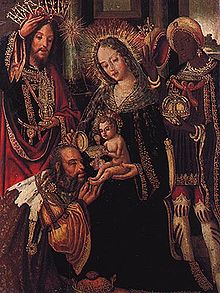Magi
Pervasive throughout the Eastern Mediterranean and West Asia until late antiquity and beyond, mágos (μάγος) was influenced by (and eventually displaced) Greek goēs (γόης), the older word for a practitioner of magic, with a meaning expanded to include astronomy, astrology, alchemy, and other forms of esoteric knowledge.In this trilingual text, certain rebels have magian as an attribute; in the Old Persian portion as maγu- (generally assumed to be a loan word from Median).Better preserved are the descriptions of the mid-5th century BC Herodotus, who in his portrayal of the Iranian expatriates living in Asia Minor uses the term "magi" in two different senses."[8] According to Robert Charles Zaehner, in other accounts :"We hear of Magi not only in Persia, Parthia, Bactria, Chorasmia, Aria, Media, and among the Sakas, but also in non-Iranian lands like Arabia, Ethiopia, and Egypt."[8]As early as the 5th century BC, Greek magos had spawned mageia and magike to describe the activity of a magus, that is, it was his or her art and practice.[17] Other Greek sources from before the Hellenistic period include the gentleman-soldier Xenophon, who had first-hand experience at the Persian Achaemenid court.Apuleius, a Numidian Platonist philosopher, describes magus to be considered as a "sage and philosopher-king" based on its Platonic notion.Lucian of Samosata (Mennipus 6) decides to journey to Babylon "to ask one of the magi, Zoroaster's disciples and successors", for their opinion.However, early church fathers, such as St. Justin, Origen, St. Augustine and St. Jerome, did not make an exception for the Gospel, and translated the word in its ordinary sense, i.e. as "magician".According to Varahamihira (c. 505 – c. 587), the statue of the Sun god (Mitra), is represented as wearing the "northern" (Central Asian) dress, specifically with horse riding boots.The velar final -g in Mair's *myag (巫) is evident in several Old Chinese reconstructions (Dong Tonghe's *mywag, Zhou Fagao's *mjwaγ, and Li Fanggui's *mjag), but not all (Bernhard Karlgren's *mywo and Axel Schuessler's *ma).Mair adduces the discovery of two figurines with unmistakably Caucasoid or Europoid features dated to the 8th century BC, found in a 1980 excavation of a Zhou dynasty palace in Fufeng County, Shaanxi Province.[citation needed] Mair's suggestion is based on a proposal by Jao Tsung-I (1990), which connects the "cross potent" bronzeware script glyph for wu 巫 with the same shape found in Neolithic West Asia, specifically a cross potent carved in the shoulder of a goddess figure of the Halaf period.In the 1980s, Saddam Hussein's Ba'ath Party used the quranic term majus during the Iran–Iraq War as an ethnic slur against Iranians, both verbally and even in official documents.






Magi (disambiguation)Magus (disambiguation)barsomsOxus TreasureAchaemenid EmpireZoroastrianismIranian religionsDarius the GreatBehistun InscriptionOld PersianHellenistic periodZurvanicEastern MediterraneanWest Asialate antiquityastronomyastrologyalchemyesotericPseudo-ZoroasterChaldeanmagicianGospel of Matthew"μάγοι" (magoi) from the eastChrist ChildOld FrenchHerbadDasturbarsomMedianAvestaYounger AvestanAvestan languagecoevalVedic SanskritGathasPersian poetryHeraclitusClemensProtrepticusHerodotusIranianAsia MinorHistoriessacerdotalRobert Charles ZaehnerPersiaParthiaBactriaChorasmiaArabiaEthiopiaAsia Minor.XenophonAchaemenidCyropaediaApuleiusNumidianPlatonistPlatonicsarcophagusAdoration of the MagiCatacombs of RomePliny the ElderNatural HistoryOstanesPythagorasEmpedoclesDemocritus"Zoroaster"pseudepigraphanecromancyAgathiasClementStromataBabylonians learned their astrologyLucian of SamosataTalmudJewish sagesBiblical MagiThree MagiBasilica of Sant'Apollinare NuovoBalthasarfrankincenseCasparMelchiorNew TestamentsSt. JustinOrigenSt. AugustineSt. JeromeJudaeaJerusalemKing HerodMessiahBethlehemStar of Bethlehemall male children two years or younger were slaughteredSimon MagusBook of ActsSergius PaulusproconsulPaphosCyprusElymasJosephusCaesareaSyriac Infancy GospelZoroastrianssura 22SabiansChristiansDay of ResurrectionVarahamihiraSakaldwipiya BrahminsMultanSamba PuranaBhavishya PuranaMahabharataŚākadvīpaBrahminal-BiruniKonarkMartandaBronzeware scriptVictor H. Mair